燃煤电厂汞标准
- 格式:doc
- 大小:59.50 KB
- 文档页数:10
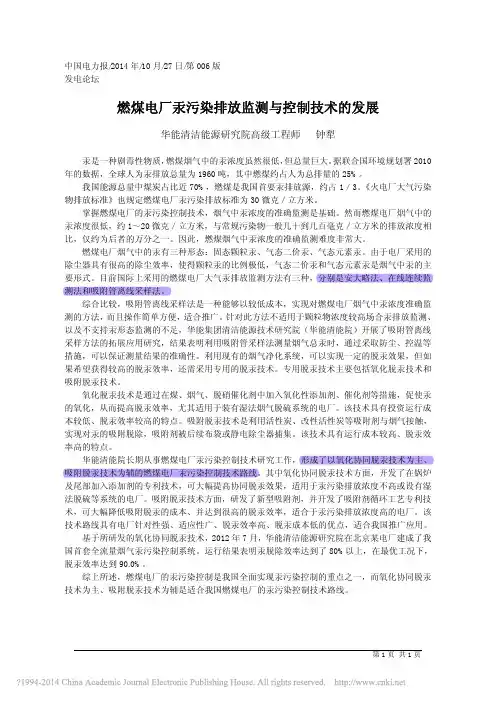
中国电力报/2014年/10月/27日/第006版发电论坛燃煤电厂汞污染排放监测与控制技术的发展华能清洁能源研究院高级工程师钟犁汞是一种剧毒性物质,燃煤烟气中的汞浓度虽然很低,但总量巨大。
据联合国环境规划署2010年的数据,全球人为汞排放总量为1960吨,其中燃煤约占人为总排量的25%。
我国能源总量中煤炭占比近70%,燃煤是我国首要汞排放源,约占1/3。
《火电厂大气污染物排放标准》也规定燃煤电厂汞污染排放标准为30微克/立方米。
掌握燃煤电厂的汞污染控制技术,烟气中汞浓度的准确监测是基础。
然而燃煤电厂烟气中的汞浓度很低,约1~20微克/立方米,与常规污染物一般几十到几百毫克/立方米的排放浓度相比,仅约为后者的万分之一。
因此,燃煤烟气中汞浓度的准确监测难度非常大。
燃煤电厂烟气中的汞有三种形态:固态颗粒汞、气态二价汞、气态元素汞。
由于电厂采用的除尘器具有很高的除尘效率,使得颗粒汞的比例极低,气态二价汞和气态元素汞是烟气中汞的主要形式。
目前国际上采用的燃煤电厂大气汞排放监测方法有三种,分别是安大略法、在线连续监测法和吸附管离线采样法。
综合比较,吸附管离线采样法是一种能够以较低成本,实现对燃煤电厂烟气中汞浓度准确监测的方法,而且操作简单方便,适合推广。
针对此方法不适用于颗粒物浓度较高场合汞排放监测、以及不支持汞形态监测的不足,华能集团清洁能源技术研究院(华能清能院)开展了吸附管离线采样方法的拓展应用研究,结果表明利用吸附管采样法测量烟气总汞时,通过采取防尘、控温等措施,可以保证测量结果的准确性。
利用现有的烟气净化系统,可以实现一定的脱汞效果,但如果希望获得较高的脱汞效率,还需采用专用的脱汞技术。
专用脱汞技术主要包括氧化脱汞技术和吸附脱汞技术。
氧化脱汞技术是通过在煤、烟气、脱硝催化剂中加入氧化性添加剂、催化剂等措施,促使汞的氧化,从而提高脱汞效率,尤其适用于装有湿法烟气脱硫系统的电厂。
该技术具有投资运行成本较低、脱汞效率较高的特点。
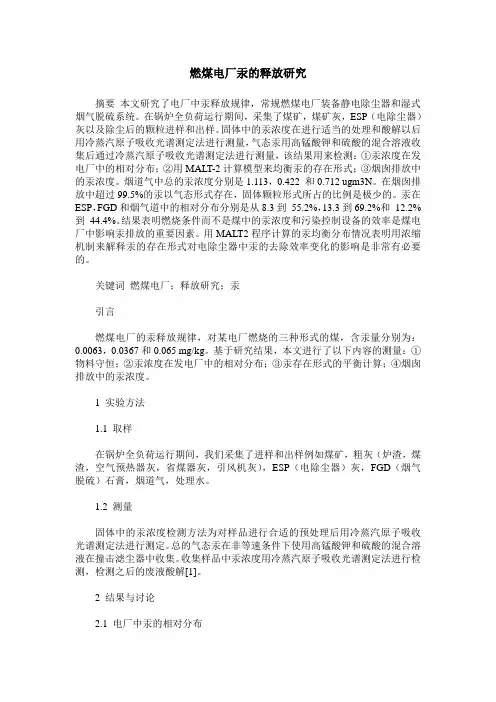
燃煤电厂汞的释放研究摘要本文研究了电厂中汞释放规律,常规燃煤电厂装备静电除尘器和湿式烟气脱硫系统。
在锅炉全负荷运行期间,采集了煤矿,煤矿灰,ESP(电除尘器)灰以及除尘后的颗粒进样和出样。
固体中的汞浓度在进行适当的处理和酸解以后用冷蒸汽原子吸收光谱测定法进行测量,气态汞用高锰酸钾和硫酸的混合溶液收集后通过冷蒸汽原子吸收光谱测定法进行测量,该结果用来检测:①汞浓度在发电厂中的相对分布;②用MALT-2计算模型来均衡汞的存在形式;③烟囱排放中的汞浓度。
烟道气中总的汞浓度分别是1.113,0.422 和0.712 ugm3N。
在烟囱排放中超过99.5%的汞以气态形式存在,固体颗粒形式所占的比例是极少的。
汞在ESP,FGD和烟气道中的相对分布分别是从8.3到55.2%,13.3到69.2%和12.2%到44.4%。
结果表明燃烧条件而不是煤中的汞浓度和污染控制设备的效率是煤电厂中影响汞排放的重要因素。
用MALT2程序计算的汞均衡分布情况表明用浓缩机制来解释汞的存在形式对电除尘器中汞的去除效率变化的影响是非常有必要的。
关键词燃煤电厂;释放研究;汞引言燃煤电厂的汞释放规律,对某电厂燃烧的三种形式的煤,含汞量分别为:0.0063,0.0367和0.065 mg/kg。
基于研究结果,本文进行了以下内容的测量:①物料守恒;②汞浓度在发电厂中的相对分布;③汞存在形式的平衡计算;④烟囱排放中的汞浓度。
1 实验方法1.1 取样在锅炉全负荷运行期间,我们采集了进样和出样例如煤矿,粗灰(炉渣,煤渣,空气预热器灰,省煤器灰,引风机灰),ESP(电除尘器)灰,FGD(烟气脱硫)石膏,烟道气,处理水。
1.2 测量固体中的汞浓度检测方法为对样品进行合适的预处理后用冷蒸汽原子吸收光谱测定法进行测定。
总的气态汞在非等速条件下使用高锰酸钾和硫酸的混合溶液在撞击滤尘器中收集。
收集样品中汞浓度用冷蒸汽原子吸收光谱测定法进行检测,检测之后的废液酸解[1]。
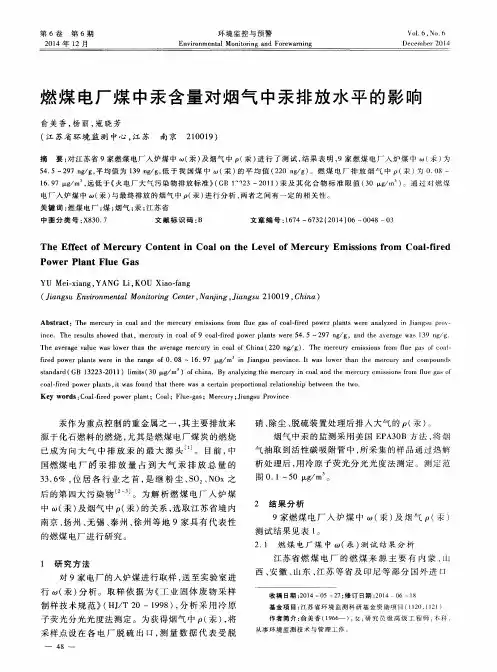


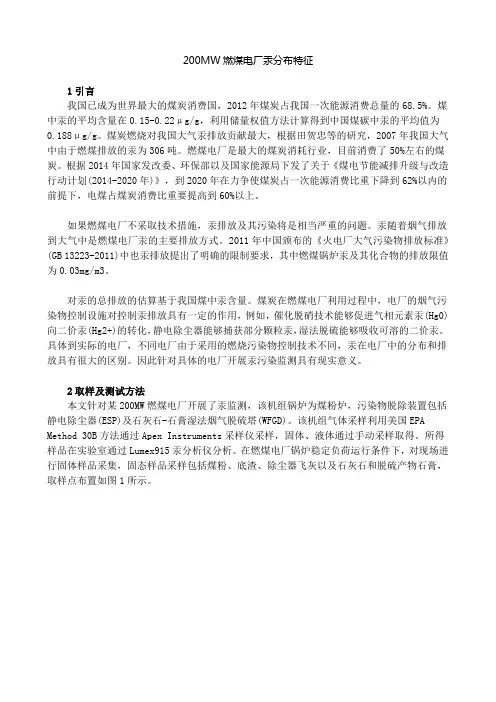
200MW燃煤电厂汞分布特征1引言我国已成为世界最大的煤炭消费国,2012年煤炭占我国一次能源消费总量的68.5%。
煤中汞的平均含量在0.15-0.22μg/g,利用储量权值方法计算得到中国煤碳中汞的平均值为0.188μg/g。
煤炭燃烧对我国大气汞排放贡献最大,根据田贺忠等的研究,2007年我国大气中由于燃煤排放的汞为306吨。
燃煤电厂是最大的煤炭消耗行业,目前消费了50%左右的煤炭。
根据2014年国家发改委、环保部以及国家能源局下发了关于《煤电节能减排升级与改造行动计划(2014-2020年)》,到2020年在力争使煤炭占一次能源消费比重下降到62%以内的前提下,电煤占煤炭消费比重要提高到60%以上。
如果燃煤电厂不采取技术措施,汞排放及其污染将是相当严重的问题。
汞随着烟气排放到大气中是燃煤电厂汞的主要排放方式。
2011年中国颁布的《火电厂大气污染物排放标准》(GB 13223-2011)中也汞排放提出了明确的限制要求,其中燃煤锅炉汞及其化合物的排放限值为0.03mg/m3。
对汞的总排放的估算基于我国煤中汞含量。
煤炭在燃煤电厂利用过程中,电厂的烟气污染物控制设施对控制汞排放具有一定的作用,例如,催化脱硝技术能够促进气相元素汞(Hg0)向二价汞(Hg2+)的转化,静电除尘器能够捕获部分颗粒汞,湿法脱硫能够吸收可溶的二价汞。
具体到实际的电厂,不同电厂由于采用的燃烧污染物控制技术不同,汞在电厂中的分布和排放具有很大的区别。
因此针对具体的电厂开展汞污染监测具有现实意义。
2取样及测试方法本文针对某200MW燃煤电厂开展了汞监测,该机组锅炉为煤粉炉,污染物脱除装置包括静电除尘器(ESP)及石灰石-石膏湿法烟气脱硫塔(WFGD)。
该机组气体采样利用美国EPA Method 30B方法通过Apex Instruments采样仪采样,固体、液体通过手动采样取得。
所得样品在实验室通过Lumex915汞分析仪分析。
在燃煤电厂锅炉稳定负荷运行条件下,对现场进行固体样品采集,固态样品采样包括煤粉、底渣、除尘器飞灰以及石灰石和脱硫产物石膏,取样点布置如图1所示。
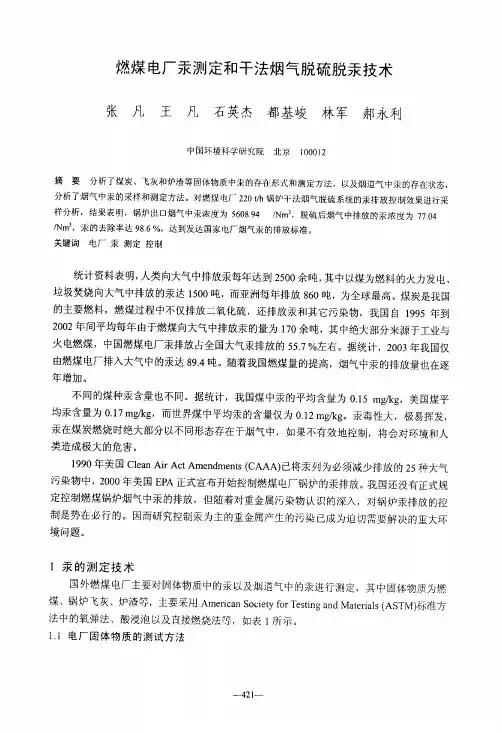
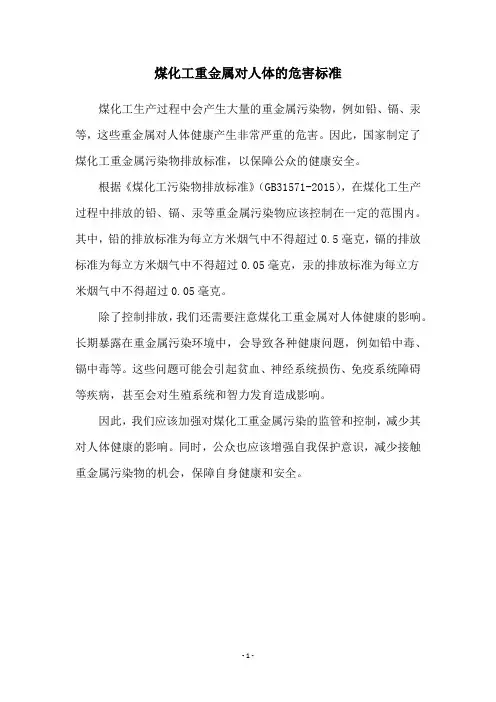
煤化工重金属对人体的危害标准
煤化工生产过程中会产生大量的重金属污染物,例如铅、镉、汞等,这些重金属对人体健康产生非常严重的危害。
因此,国家制定了煤化工重金属污染物排放标准,以保障公众的健康安全。
根据《煤化工污染物排放标准》(GB31571-2015),在煤化工生产过程中排放的铅、镉、汞等重金属污染物应该控制在一定的范围内。
其中,铅的排放标准为每立方米烟气中不得超过0.5毫克,镉的排放标准为每立方米烟气中不得超过0.05毫克,汞的排放标准为每立方
米烟气中不得超过0.05毫克。
除了控制排放,我们还需要注意煤化工重金属对人体健康的影响。
长期暴露在重金属污染环境中,会导致各种健康问题,例如铅中毒、镉中毒等。
这些问题可能会引起贫血、神经系统损伤、免疫系统障碍等疾病,甚至会对生殖系统和智力发育造成影响。
因此,我们应该加强对煤化工重金属污染的监管和控制,减少其对人体健康的影响。
同时,公众也应该增强自我保护意识,减少接触重金属污染物的机会,保障自身健康和安全。
- 1 -。
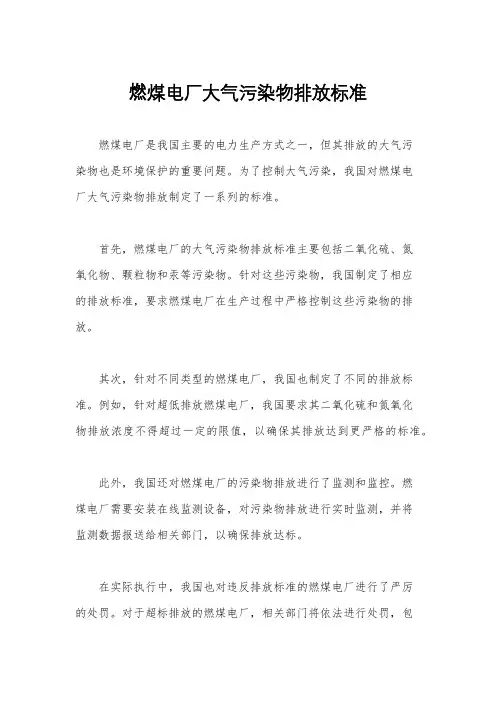
燃煤电厂大气污染物排放标准
燃煤电厂是我国主要的电力生产方式之一,但其排放的大气污
染物也是环境保护的重要问题。
为了控制大气污染,我国对燃煤电
厂大气污染物排放制定了一系列的标准。
首先,燃煤电厂的大气污染物排放标准主要包括二氧化硫、氮
氧化物、颗粒物和汞等污染物。
针对这些污染物,我国制定了相应
的排放标准,要求燃煤电厂在生产过程中严格控制这些污染物的排放。
其次,针对不同类型的燃煤电厂,我国也制定了不同的排放标准。
例如,针对超低排放燃煤电厂,我国要求其二氧化硫和氮氧化
物排放浓度不得超过一定的限值,以确保其排放达到更严格的标准。
此外,我国还对燃煤电厂的污染物排放进行了监测和监控。
燃
煤电厂需要安装在线监测设备,对污染物排放进行实时监测,并将
监测数据报送给相关部门,以确保排放达标。
在实际执行中,我国也对违反排放标准的燃煤电厂进行了严厉
的处罚。
对于超标排放的燃煤电厂,相关部门将依法进行处罚,包
括罚款、停产整顿等措施,以确保排放标准得到严格执行。
总的来说,燃煤电厂大气污染物排放标准的制定和执行,对于保护环境、改善空气质量具有重要意义。
我国将继续加大对燃煤电厂的排放标准执行力度,推动燃煤电厂向清洁、低排放方向发展,为环境保护作出更大的贡献。
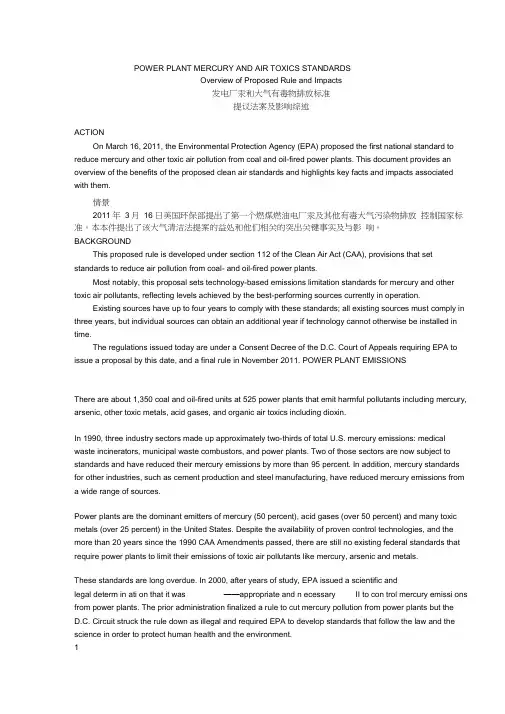
POWER PLANT MERCURY AND AIR TOXICS STANDARDSOverview of Proposed Rule and Impacts发电厂汞和大气有毒物排放标准提议法案及影响综述ACTIONOn March 16, 2011, the Environmental Protection Agency (EPA) proposed the first national standard to reduce mercury and other toxic air pollution from coal and oil-fired power plants. This document provides an overview of the benefits of the proposed clean air standards and highlights key facts and impacts associated with them.情景2011年3月16 日美国环保部提出了第一个燃煤燃油电厂汞及其他有毒大气污染物排放控制国家标准。
本本件提出了该大气清洁法提案的益处和他们相关的突出关键事实及与影响。
BACKGROUNDThis proposed rule is developed under section 112 of the Clean Air Act (CAA), provisions that set standards to reduce air pollution from coal- and oil-fired power plants.Most notably, this proposal sets technology-based emissions limitation standards for mercury and other toxic air pollutants, reflecting levels achieved by the best-performing sources currently in operation.Existing sources have up to four years to comply with these standards; all existing sources must comply in three years, but individual sources can obtain an additional year if technology cannot otherwise be installed in time.The regulations issued today are under a Consent Decree of the D.C. Court of Appeals requiring EPA to issue a proposal by this date, and a final rule in November 2011. POWER PLANT EMISSIONSThere are about 1,350 coal and oil-fired units at 525 power plants that emit harmful pollutants including mercury, arsenic, other toxic metals, acid gases, and organic air toxics including dioxin.In 1990, three industry sectors made up approximately two-thirds of total U.S. mercury emissions: medical waste incinerators, municipal waste combustors, and power plants. Two of those sectors are now subject to standards and have reduced their mercury emissions by more than 95 percent. In addition, mercury standards for other industries, such as cement production and steel manufacturing, have reduced mercury emissions from a wide range of sources.Power plants are the dominant emitters of mercury (50 percent), acid gases (over 50 percent) and many toxic metals (over 25 percent) in the United States. Despite the availability of proven control technologies, and the more than 20 years since the 1990 CAA Amendments passed, there are still no existing federal standards that require power plants to limit their emissions of toxic air pollutants like mercury, arsenic and metals.These standards are long overdue. In 2000, after years of study, EPA issued a scientific andlegal determ in ati on that it was ——appropriate and n ecessary II to con trol mercury emissi ons from power plants. The prior administration finalized a rule to cut mercury pollution from power plants but the D.C. Circuit struck the rule down as illegal and required EPA to develop standards that follow the law and the science in order to protect human health and the environment.1While newer, and a significant percentage of older, power plants already control their emissions of mercury, heavy metals, and acid gases, about half of the current electric generating units (EGUs) still do not have advanced pollution control equipment. EMISSION REDUCTIONS RESULTING FROM COMPLIANCE WITH THE PROPOSED STANDARDSThe proposed rule establishes emission standards for mercury, acid gases (hydrochloric acid, or HCl, as a surrogate), and non-mercury metallic toxic pollutants (total particulate matter (PM) as a surrogate with alternative surrogate of total metal air toxics), and each year would:oPrevent 91 percent of the mercury in coal burned in power plants from being emitted to the air;oReduce acid gas emissions from power plans by 91 percent; and oReduce sulfur dioxide (SO2) emissions from power plants by 55 percent.HEALTH BENEFITS OF THE PROPOSED STANDARDSBy updating safeguards under the Clean Air Act to reduce mercury, acid gases, and other life-threatening pollution in our air, EPA is acting to protect our health and our families from the illnesses—and premature deaths—linked to these pollutants.Uncontrolled releases of toxic air pollutants like mercury from power plants damage children ' s developing brains, reducing their IQ and their ability to learn.They cause a range of dangerous health problems in adults as well, including cancer, heart disease and premature death. Mercury and many of the other air toxics also pollute our nation ' s lakes, streams, and rivers. Fish advisories have been issued across the US as a result of mercury contamination.The proposed standards will have direct benefits to neighborhoods near power plants as well as neighborhoods hundreds of miles away from the nearest power plant.Each year the standards will prevent serious illnesses and health problems for thousands of Americans, including: up to 17,000 premature deaths, 11,000 heart attacks, 120,000 asthma attacks, 12,200 hospital and emergency room visits, 4,500 cases of chronic bronchitis, and 5.1 million restricted activity days.The value of the air quality improvements totals $59 billion to $140 billion each year. That means that for every dollar spent to reduce this pollution, Americans get $5-13 in healthbenefits.The benefits are widely distributed and are especially important to minority and low income populations who are disproportionately impacted by asthma and other debilitating health conditions.INVESTMENTS THAT KEEP PEOPLE WORKING AND CREATE JOBSEach year, 850,000 missed work or —sick II days will be avoided, enhancing productivity, lowering health care costs for American families.Money spent on pollution control at power plants creates high-quality American jobs in manufacturing steel, cement and other materials needed to build pollution control equipment, in creating and assembling pollution control equipment, in installing the equipment at power plants, and operating and maintaining the equipment once it is installed.EPA estimates this proposed rule will provide employment for thousands by supporting 31,000 short-term construction jobs and 9,000 long-term utility jobs.2The standards will maintain fuel diversity:oCoal-fired generation becomes much cleaner with little effect on its role as the major generator of U.S. electric power.oEPA' s modeling shows that plants totaling lessthan 10 GW of the nation -'firesdcoalcapacity (not generation) are expected to retire by 2015 rather than invest in control technologies, which represents about a 2 percent decrease in coal-fired generation. The plants that are expected to retire areprimarily the smaller, less efficient and higher polluting units that are not used much.REGULATORY CERTAINTY AND A LEVEL PLAYING FIELD FOR CLEANER ENERGY SOURCESThese updated and long overdue Clean Air Act standards will provide regulatory certainty, opening up opportunities for investment.These proposed standards will result in the upgrading of existing controls (in particular PM controls like electrostatic precipitators or ESPs) and the installation of good engineering con trols (in cludi ng dry sorbe nt injectio n or DSI) —all of which is achievable by the 2015compliance timeline.History has shown that power plants can install controls well within the timeframes required by the Clean Air Act. From 2001 to 2003, 150 GW of new generation was built; from 2008 to 2010, about 20 GW of scrubbers was installed each year. The proposed standards will level the playing field so that all power plants will have to limit their emissions of mercury as plants in some states already do. Installing these widely-available controls willhelp modernize the aging fleet of uncontrolled power plants, most of which are over 30 years old and many of which are over 50 years old.EPA modeling indicates that these proposed standards will result in relatively small changes in the averageretail price of electricity, primarily due to increased demand for natural gaskeeping electricity prices below 1990 levels.This translates into a 1.3 percent increase in residential natural gas prices and a consumer electricity price increase of approximately $3-4 per month.In addition to the proposed standards for toxic air pollutants, EGUs are the subject of other rulemakings, addressing the interstate transport of emissions contributing to ozone and particulate matter air quality problems, coal combustion wastes, cooling water control requirements and greenhouse gas emissions. To thefull extent that the agency obligations permit, EPA plans to take into account the combined effects of theses legal upcoming actions on the industry in its decision-making process, and to approach these rulemakings in waysthat allow the industry to make practical, integrated compliance decisions that minimize costs while stillachieving the fundamentally important public health and environmental benefits intended under the Clean AirAct.COMPLIANCE PLANNING , SYSTEM RELIABILITY AND LOW COST ELECTRICITYEPA, FERC and DOE will work with entities whose responsibility is to ensure an affordable, reliable supply of electricity, including State Utility Commissions, Regional Transmission Organizations (RTOs), the National Electric Reliability Council (NERC) to share information and encourage them to begin planning for compliance and reliability as early as possible.3Early planning and actions to spur or support early planning by power companies, utility regulators and system operators can do much to ensure orderly, affordable compliance with the standards.EPA modeling indicates that including energy efficiency investments that achieve moderate levels of energy demand reduction in compliance strategies will: oCut substantially total emissions control costs for the power sector;oLower the incremental cost of the standards by more than half in 2020;oLower consumer bills; andoReduce emissions of air pollutants beyond what the standards would achieve, especially on high electricity demand days when air quality is most threatened. KEY FEATURES OF THE PROPOSED RULEEmissions standards set under the toxics program are federal air pollution limits that individual facilities must meet by a set date. EPA must set emission standards for existing sources in the category that are at least as stringent as the emission reductions achieved by the average of the top 12 percent best controlled sources. EPA must establish standards for all listed hazardous air pollutants (HAPs) emitted from each industry category.The proposed rule sets sta ndards -based on the best-perform ing con trols curre ntly in operati on —for all HAPs emitted by coal and oil-fired EGUs with a capacity of 25 megawatts or greater. All regulated EGUs are considered major. EPA did not identify any size, design or engineering distinction between major and area sources in this categoryEPA is proposing to subcategorize:oA certain class of coal-fired boilers located at mine mouths that are generally designed to burn lignite coal. The mercury limit in this subcategory is based on“beyond the floor II emission reductionpxptunities because EPA analysis shows thatbetter controls are widely available and affordable.oSolid and liquid oil units because even though petroleum coke is derived from oil, it is a solid fuel and cannot be burned in a liquid oil-fired boiler.EPA is not propos ing less-stri ngent alter native sta ndards (called -based e—ihsialrtlslimits I or HBEL), which the Administrator has the discretion to consider if she determines that an HBEL will mandate reductions sufficient to protect individuals most exposed to toxicpollutants. The many HAPs EGUs emit in high amounts negate the basis for adopting this less stringentapproach.) beca EPA is not proposing a separate subcategory for coal refuse units (aka ― waste coalour analysis did not indicate that such subcategorization was necessary or warranted.EPA is providing flexibility by allowing facility-wide averaging for all HAPs emissions from existing units withinthe same subcategory. This will allow equivalent, less costly way of achieving emissions standards.The proposed rule takes advantage of state-of-the-art high quality monitoring: oCEMs for numeric standards (mercury, HCl or SO2, and PM) oEmissions testing, parameter monitoring, and fuel analyses allowed for metals and acid gases; sorbant trapsallowed for mercury oThirty day averaging period to accommodates process variability and, coupled withCEMS, facilitates complianceThe proposed standards will establish achievable numerical emission limits for mercury, PM (as the surrogatefor non-mercury metals, with options for measuring the metals) and 4hydrogen chloride (as the surrogate for acid gases with an option for measuring SO2, or the individual acid gases).oRecords of work practice standards are proposed for organic HAP emissions to ensure proper combustion which prevents formation of organic HAPs, and in recognition of current low levels of emissions near detection limits.5。
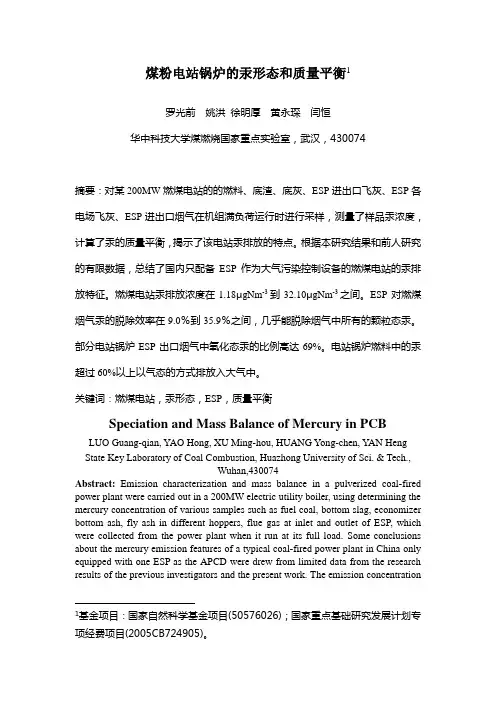
煤粉电站锅炉的汞形态和质量平衡1罗光前姚洪徐明厚黄永琛闫恒华中科技大学煤燃烧国家重点实验室,武汉,430074摘要:对某200MW燃煤电站的的燃料、底渣、底灰、ESP进出口飞灰、ESP各电场飞灰、ESP进出口烟气在机组满负荷运行时进行采样,测量了样品汞浓度,计算了汞的质量平衡,揭示了该电站汞排放的特点。
根据本研究结果和前人研究的有限数据,总结了国内只配备ESP作为大气污染控制设备的燃煤电站的汞排放特征。
燃煤电站汞排放浓度在1.18μgNm-3到32.10μgNm-3之间。
ESP对燃煤烟气汞的脱除效率在9.0%到35.9%之间,几乎能脱除烟气中所有的颗粒态汞。
部分电站锅炉ESP出口烟气中氧化态汞的比例高达69%。
电站锅炉燃料中的汞超过60%以上以气态的方式排放入大气中。
关键词:燃煤电站,汞形态,ESP,质量平衡Speciation and Mass Balance of Mercury in PCB LUO Guang-qian, YAO Hong, XU Ming-hou, HUANG Yong-chen, YAN Heng State Key Laboratory of Coal Combustion, Huazhong University of Sci. & Tech.,Wuhan,430074Abstract: Emission characterization and mass balance in a pulverized coal-fired power plant were carried out in a 200MW electric utility boiler, using determining the mercury concentration of various samples such as fuel coal, bottom slag, economizer bottom ash, fly ash in different hoppers, flue gas at inlet and outlet of ESP, which were collected from the power plant when it run at its full load. Some conclusions about the mercury emission features of a typical coal-fired power plant in China only equipped with one ESP as the APCD were drew from limited data from the research results of the previous investigators and the present work. The emission concentration of mercury was ranged from 1.18μgNm-3 to 32.10μgNm-3. ESP could remove 9.0%~35.9%of total mercury and nearly all the particulate mercury in the flue gas. The oxidized mercury fraction of the flue gas at the outlet of ESP in partial power plant was up to 69%. More than 60% of the total mercury entered the electric utility boiler was emitted into the atmosphere air in gas phase.Key words: coal-fired power plant, mercury speciation, ESP, mass balance1.引言1953-1959年,日本发生了震惊世界的环境污染事件,被称为“世界八大公害”的“水俣病事件”,汞中毒使人和动物出现严重的脑神经疾病,大量发疯或死亡。
江苏省燃煤电厂入炉煤汞含量水平浅析煤中汞含量由于在样品数量、所选煤种、分析方法等方面的选择存在差异,不同研究结果给出的煤中汞含量差异较大。
本文基于江苏省9家燃煤电厂入炉煤相关实测的数据,得出了江苏省燃煤电厂入炉煤中汞含量在0.0545~0.297mg/kg,并对影响煤中汞含量的因素进行了分析。
标签:燃煤电厂入炉煤汞1前言煤中汞含量是影响大气汞排放的重要参数之一,不同地区、不同煤种的煤含汞量是不同的。
现有的研究结果由于在样品数量、所选煤种、分析方法等方面存在差异,导致煤中汞含量的测试结果有所差异。
根据美国新泽西环境保护组织(NJ DEPE)(1993)统计表明煤中汞的平均含量在0.12~0.28mg/kg范围内。
根据中国矿业大学张军营990个样品的测试结果,我国煤中汞含量在0.003~10.5mg/kg范围内,算术平均值为0.158mg/kg[1];王启超等人也对我国主要产煤省份煤炭的汞含量进行了测定,结果表明我国的煤炭中平均含汞量为0.22mg/kg[2];浙江大学任建莉认为,我国大多数煤中自然含汞量不高,平均汞含量取0.15mg/kg为宜[3]。
江苏省现有装机容量30万千瓦以上燃煤电厂共43家133台机组,不论机组数量还是装机总量都位于全国前列。
因此,选择具有代表性的燃煤电厂进行入炉煤的测试对判断江苏省燃煤电厂的煤中汞含量情况具有重要意义。
2研究对象的选择为了保证研究结果具有代表性,选取了9家分布于江苏省境内的南京、扬州、无锡、泰州、徐州等不同区域的电厂作为研究对象,单机容量涵盖50MW、135MW、300MW、320MW、600MW、1000MW等机组,能全面表征江苏省境内燃煤机组煤中汞含量情况,研究对象具体分布见图1。
3入炉煤中汞含量的分析对所选择的9家燃煤电厂的入炉煤进行取样,煤粉样品采自炉前煤,炉前煤为经过破碎研磨的煤粉。
样品采集后装入自封袋编号送上海市环境监测中心进行分析,分析仪器采用RA-915M汞分析仪,该仪器不使用汞齐法,而是采用塞曼效应背景校正原子吸收光谱技术,使用更方便更可靠。
燃煤烟气中汞的含量9~23μg/m³,属于痕量级污染物,主要有三种形态:气态单质汞Hg(g),气态氧化物汞Hg2+(g)和固态颗粒汞Hg(p)。
其中气态单质汞在大气中停留时间长,易挥发,难溶于水,难以捕集。
主要的燃煤烟气控制技术分研究技术集中在三方面:燃烧前脱汞、燃烧中脱汞和燃烧后脱汞。
其中以燃烧后脱汞研究最为广泛。
①燃烧前脱汞:主要包括洗煤技术和煤的热处理技术;煤的热处理技术是利用工的高挥发性,在加热过程中,汞会挥发出来。
研究显示,加热到400℃时,能去除80%的汞。
②燃烧中脱汞:主要原理是改进煤的燃烧方式,有流化床技术和低氮燃烧技术。
这一部分在中国研究较少。
③燃烧后脱汞:有利用现有烟气治理设备脱汞、和吸附剂脱汞。
烟气治理设备包括除尘装置、脱硫装置和脱硝装置,吸附剂主要有活性炭、飞灰等对气态单质汞去除有特效。
新型脱汞方法有络合法,是一种综合治理的方法以HgCl2为吸收液,将气态质转化为氯化亚汞。
再电解氯化亚汞。
许明明
120710228。
汞撒利类在燃煤电厂中的排放特征和控制技术研究汞是一种常见的有毒物质,其排放对环境和人类健康造成了严重影响。
特别是燃煤电厂作为重要的汞排放源,其排放对全球大气汞污染有着重要的贡献。
因此,研究燃煤电厂中汞排放的特征和控制技术具有重要意义。
首先,让我们了解汞撒利类在燃煤电厂中的排放特征。
燃煤电厂主要通过燃烧煤炭来产生电力,而燃烧过程中汞主要以元素汞(Hg0)、离子汞(Hg2+)和颗粒态汞(Hgp)三种形态排放。
元素汞是汞的最常见形态,占据了燃煤电厂排放总量的大部分。
离子汞和颗粒态汞的排放量相对较少。
其次,燃煤电厂中汞排放的控制技术是必不可少的。
针对燃煤电厂汞排放的特点,研究和实施有效的控制技术可以显著降低汞排放,并减少对环境的负面影响。
目前,常用的汞排放控制技术主要包括以下几种:1. 燃烧优化技术:通过优化煤种选择和燃烧条件,可以有效降低燃煤电厂中的汞排放。
例如,选择低汞含量的燃料,优化燃烧温度和压力等参数,可以降低燃烧过程中汞的生成和排放。
2. 烟气净化技术:燃煤电厂中常用的烟气净化技术包括静电除尘器和脱硫脱硝设备。
这些设备可以通过捕集汞颗粒和汞物质,将其从烟气中去除。
然而,传统的净化技术对于气态汞的去除效果较差,因此需要结合其他技术进行改进。
3. 激活炭吸附技术:激活炭是一种具有很强吸附性能的材料,可以用于捕集汞。
将激活炭投入燃煤电厂的烟道系统中,可以有效地吸附烟气中的汞,达到减少汞排放的目的。
同时,捕集的汞可以进行有效的回收和处理。
4. 汞稳定剂技术:汞稳定剂是一种能够与汞形成稳定化合物的化学物质。
通过添加汞稳定剂到煤炭或燃烧过程中,可以显著降低汞排放。
这种技术被广泛应用于燃煤电厂和其他燃烧过程中,具有较好的效果。
总的来说,燃煤电厂中汞撒利类的排放特征和控制技术的研究具有重要的意义。
通过深入了解汞排放的来源和特点,有针对性地实施汞排放控制技术,可以有效降低燃煤电厂对环境的污染,减少对人体健康的危害。
环境与健康杂志2010年3月第27卷第3期J Environ Health,March 2010,Vol.27,No.3【工作交流】文章编号:1001-5914(2010)03-0270-02燃煤电厂烟气中汞的监测方法评价武成利1,2,曹晏2,董众兵1,潘伟平2关键词:空气污染;汞;燃煤电厂;监测方法中图分类号:X830.2文献标识码:C作者单位:1.安徽理工大学化学工程学院(安徽淮南232001);2.美国西肯塔基大学(美国42101)作者简介:武成利(1976-),男,讲师,博士研究生,从事环境和化工方面的研究。
燃煤电厂是主要的人为汞排放源之一,占人为排放的三分之一[1,2]。
汞在燃煤电厂以3种形态存在:零价汞(Hg 0)、氧化态汞(Hg 2+)和颗粒态汞(Hg p ),零价汞不能溶于水,很难脱除;颗粒态汞一般经过静电除尘器(ESP )除去[3];Hg 2+能溶于水,通过湿法脱硫装置(Wet FGD )既能脱SO 2又能脱除Hg 2+。
2005年3月,美国环保署(EPA )颁布了洁净空气汞控制条例(CAMR )[4]。
为实时监控各个电厂汞的排放,要求燃煤电厂安装可行的汞监测设备[5]。
本研究采用安大略法(OHM )、连续汞监测法(Hg CEM )、半连续汞监测法(Hg SCEM )和吸附剂捕获方法(Appendix K )在燃煤电厂的烟气排入大气的最终排放点烟囱上进行汞浓度监测,比较4种汞监测方法的可行性和有效性。
1材料与方法1.1电厂测试机组情况和煤样分析该电厂锅炉是205MW 的煤粉炉,烟气污染物控制设备包括选择性催化还原脱硝装置、冷侧静电除尘器和石灰石-石膏湿法脱硫装置。
电厂燃烧用煤为烟煤,煤的空气干燥基的水分、灰分和挥发分分别为8.85%,10.70%和34.92%。
空气干燥基碳、氢、氧、氮和硫元素分析结果分别为63.43%,5.52%,15.26%,1.18%和3.91%(质量分数);汞、氟和氯分析结果分别为0.11,49.46和1936.64mg/kg 。
POWER PLANT MERCURY AND AIR TOXICS STANDARDSOverview of Proposed Rule and Impacts发电厂汞和大气有毒物排放标准提议法案及影响综述ACTIONOn March 16, 2011, the Environmental Protection Agency (EPA) proposed the first national standard to reduce mercury and other toxic air pollution from coal and oil-fired power plants. This document provides an overview of the benefits of the proposed clean air standards and highlights key facts and impacts associated with them.情景2011年3月16日美国环保部提出了第一个燃煤燃油电厂汞及其他有毒大气污染物排放控制国家标准。
本本件提出了该大气清洁法提案的益处和他们相关的突出关键事实及与影响。
BACKGROUNDThis proposed rule is developed under section 112 of the Clean Air Act (CAA), provisions that set standards to reduce air pollution from coal- and oil-fired power plants.Most notably, this proposal sets technology-based emissions limitation standards for mercury and other toxic air pollutants, reflecting levels achieved by the best-performing sources currently in operation.Existing sources have up to four years to comply with these standards; all existing sources must comply in three years, but individual sources can obtain an additional year iftechnology cannot otherwise be installed in time.The regulations issued today are under a Consent Decree of the D.C. Court of Appeals requiring EPA to issue a proposal by this date, and a final rule in November 2011.POWER PLANT EMISSIONS.There are about 1,350 coal and oil-fired units at 525 power plants that emit harmfulpollutants including mercury, arsenic, other toxic metals, acid gases, and organic air toxics including dioxin..In 1990, three industry sectors made up approximately two-thirds of total U.S. mercury emissions: medical waste incinerators, municipal waste combustors, and power plants. Twoof those sectors are now subject to standards and have reduced their mercury emissions bymore than 95 percent. In addition, mercury standards for other industries, such as cement production and steel manufacturing, have reduced mercury emissions from a wide range of sources..Power plants are the dominant emitters of mercury (50 percent), acid gases (over 50 percent)and many toxic metals (over 25 percent) in the United States. Despite the availability ofproven control technologies, and the more than 20 years since the 1990 CAA Amendments passed, there are still no existing federal standards that require power plants to limit their emissions of toxic air pollutants like mercury, arsenic and metals.These standards are long overdue. In 2000, after years of study, EPA issued a scientific and lega l determination that it was ―appropriate and necessary‖ to control mercury emissions from power plants. The prior administration finalized a rule to cut mercury pollution from power plants but the D.C. Circuit struck the rule down as illegal and required EPA to develop standards that follow the law and the science in order to protect human health and the environment.1.While newer, and a significant percentage of older, power plants already control their emissions of mercury, heavy metals, and acid gases, about half of the current electric generating units (EGUs) still do not have advanced pollution control equipment.EMISSION REDUCTIONS RESULTING FROM COMPLIANCE WITH THE PROPOSED STANDARDSThe proposed rule establishes emission standards for mercury, acid gases (hydrochloric acid, or HCl, as a surrogate), and non-mercury metallic toxic pollutants (total particulate matter (PM) as a surrogate with alternative surrogate of total metal air toxics), and each year would:oPrevent 91 percent of the mercury in coal burned in power plants from being emitted tothe air;oReduce acid gas emissions from power plans by 91 percent; andoReduce sulfur dioxide (SO2) emissions from power plants by 55 percent.HEALTH BENEFITS OF THE PROPOSED STANDARDS.By updating safeguards under the Clean Air Act to reduce mercury, acid gases, and otherlife-threatening pollution in our air, EPA is acting to protect our health and our families from the illnesses—and premature deaths—linked to these pollutants..Uncontrolled releases of toxic air pollutants like mercury from power plants damage children’s developing brains, reducing their IQ and their ability to learn..They cause a range of dangerous health problems in adults as well, including cancer, heart disease and premature death. Mercury and many of the other air toxics also pollute our nation’s lakes, streams, and rivers. Fish advisories have been issued across the US as a resultof mercury contamination..The proposed standards will have direct benefits to neighborhoods near power plants as well as neighborhoods hundreds of miles away from the nearest power plant..Each year the standards will prevent serious illnesses and health problems for thousands of Americans, including: up to 17,000 premature deaths, 11,000 heart attacks, 120,000 asthma attacks, 12,200 hospital and emergency room visits, 4,500 cases of chronic bronchitis, and5.1 million restricted activity days..The value of the air quality improvements totals $59 billion to $140 billion each year. That means that for every dollar spent to reduce this pollution, Americans get $5-13 in healthbenefits..The benefits are widely distributed and are especially important to minority and low income populations who are disproportionately impacted by asthma and other debilitating health conditions.INVESTMENTS THAT KEEP PEOPLE WORKING AND CREATE JOBS.Each year, 850,000 missed work or ―sick‖ days will be avoided, enhancing productivity, lowering health care costs for American families..Money spent on pollution control at power plants creates high-quality American jobs in manufacturing steel, cement and other materials needed to build pollution control equipment, in creating and assembling pollution control equipment, in installing the equipment at power plants, and operating and maintaining the equipment once it is installed..EPA estimates this proposed rule will provide employment for thousands by supporting 31,000 short-term construction jobs and 9,000 long-term utility jobs.2.The standards will maintain fuel diversity:oCoal-fired generation becomes much cleaner with little effect on its role as the major generator of U.S. electric power.oEPA’s modeling shows that plants totaling less than 10 GW of the nation’s coal-fired capacity (not generation) are expected to retire by 2015 rather than invest in control technologies, which represents about a 2 percent decrease in coal-fired generation.The plants that are expected to retire are primarily the smaller, less efficient andhigher polluting units that are not used much.REGULATORY CERTAINTY AND A LEVEL PLAYING FIELD FOR CLEANER ENERGY SOURCES.These updated and long overdue Clean Air Act standards will provide regulatory certainty, opening up opportunities for investment..These proposed standards will result in the upgrading of existing controls (in particular PM controls like electrostatic precipitators or ESPs) and the installation of good engineering controls (including dry sorbent injection or DSI) – all of which is achievable by the 2015 compliance timeline..History has shown that power plants can install controls well within the timeframes required by the Clean Air Act. From 2001 to 2003, 150 GW of new generation was built; from 2008 to 2010, about 20 GW of scrubbers was installed each year. The proposed standards will level the playing field so that all power plants will have to limit their emissions of mercury as plants in some states already do. Installing these widely-available controls will help modernize the aging fleet of uncontrolled power plants, most of which are over 30 years old and many of which are over 50 years old..EPA modeling indicates that these proposed standards will result in relatively small changes in the average retail price of electricity, primarily due to increased demand for natural gas- keeping electricity prices below 1990 levels..This translates into a 1.3 percent increase in residential natural gas prices and a consumer electricity price increase of approximately $3-4 per month..In addition to the proposed standards for toxic air pollutants, EGUs are the subject of other rulemakings, addressing the interstate transport of emissions contributing to ozone and particulate matter air quality problems, coal combustion wastes, cooling water control requirements and greenhouse gas emissions. To the full extent that the agency’s legal obligations permit, EPA plans to take into account the combined effects of these upcomingactions on the industry in its decision-making process, and to approach these rulemakings in ways that allow the industry to make practical, integrated compliance decisions that minimize costs while still achieving the fundamentally important public health and environmental benefits intended under the Clean Air Act.COMPLIANCE PLANNING, SYSTEM RELIABILITY AND LOW COST ELECTRICITY.EPA, FERC and DOE will work with entities whose responsibility is to ensure an affordable, reliable supply of electricity, including State Utility Commissions, Regional Transmission Organizations (RTOs), the National Electric Reliability Council (NERC) to share information and encourage them to begin planning for compliance and reliability as early as possible.3.Early planning and actions to spur or support early planning by power companies, utility regulators and system operators can do much to ensure orderly, affordable compliance with the standards..EPA modeling indicates that including energy efficiency investments that achieve moderate levels of energy demand reduction in compliance strategies will:oCut substantially total emissions control costs for the power sector;oLower the incremental cost of the standards by more than half in 2020;oLower consumer bills; andoReduce emissions of air pollutants beyond what the standards would achieve,especially on high electricity demand days when air quality is most threatened.KEY FEATURES OF THE PROPOSED RULE.Emissions standards set under the toxics program are federal air pollution limits that individual facilities must meet by a set date. EPA must set emission standards for existing sources in the category that are at least as stringent as the emission reductions achieved by the average of the top 12 percent best controlled sources. EPA must establish standards for all listed hazardous air pollutants (HAPs) emitted from each industry category..The proposed rule sets standards – based on the best-performing controls currently in operation – for all HAPs emitted by coal and oil-fired EGUs with a capacity of 25 megawatts or greater. All regulated EGUs are considered major. EPA did not identify any size, design or engineering distinction between major and area sources in this category.EPA is proposing to subcategorize:oA certain class of coal-fired boilers located at mine mouths that are generallydesigned to burn lignite coal. The mercury limit in this subcategory is based on“beyond the floor‖ emission reduction op portunities because EPA analysis shows that better controls are widely available and affordable.oSolid and liquid oil units because even though petroleum coke is derived from oil, itis a solid fuel and cannot be burned in a liquid oil-fired boiler..EPA is not proposing less-stringent alternative standards (called ―health-based emissions limits‖ or HBEL), which the Administrator has the discretion to consider if she determines that an HBEL will mandate reductions sufficient to protect individuals most exposed to toxicpollutants. The many HAPs EGUs emit in high amounts negate the basis for adopting this less stringent approach..EPA is not proposing a separate subcategory for coal refuse units (aka ―waste coal‖) because our analysis did not indicate that such subcategorization was necessary or warranted..EPA is providing flexibility by allowing facility-wide averaging for all HAPs emissions from existing units within the same subcategory. This will allow equivalent, less costly way of achieving emissions standards..The proposed rule takes advantage of state-of-the-art high quality monitoring:oCEMs for numeric standards (mercury, HCl or SO2, and PM)oEmissions testing, parameter monitoring, and fuel analyses allowed for metals andacid gases; sorbant traps allowed for mercuryoThirty day averaging period to accommodates process variability and, coupled with CEMS, facilitates compliance.The proposed standards will establish achievable numerical emission limits for mercury, PM (as the surrogate for non-mercury metals, with options for measuring the metals) and4hydrogen chloride (as the surrogate for acid gases with an option for measuring SO2, or the individual acid gases).oRecords of work practice standards are proposed for organic HAP emissions to ensure proper combustion which prevents formation of organic HAPs, and in recognition of current low levels of emissions near detection limits.5。